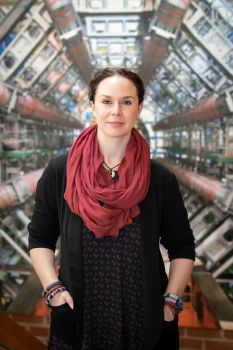
Dr Kate Shaw
- CERN physicists release collision data from the ATLAS experiment
- Public and students challenged to find new science
Sussex scientists working on the Large Hadron Collider at CERN in Geneva have just released a huge amount of data inviting students and the public to rediscover the Higgs Boson or even to find Dark Matter. The scientific treasure trove comes from the ATLAS experiment at CERN, which is one of the collaborations which made world news when it discovered the Higgs Boson in 2012.
The ATLAS collaboration, comprised of scientists from institutions across the world, has now published data relating to 1 quadrillion proton-proton collisions (that's 1 followed by 15 zeros). Contained in that data are 500 thousand Higgs bosons. This is around the same amount of data that the ATLAS Collaboration used to discover the Higgs boson in 2012.
Dr Kate Shaw, lecturer in physics with the School of Mathematical and Physical Sciences at the University of Sussex, who co-leads the ATLAS Open Data team and was part of the team to discover the Higgs Boson, said:
"For the first time, students and members of the public will be able to 're-discover' the Higgs boson. They can even search through the data for physics beyond the Standard Model – that is, the accepted understanding of the particles making up our universe - such as Dark Matter. These new avenues for study should boost students' understanding of the experimental side of data analysis which is particularly exciting for budding researchers. And we're providing the tools and documentation to allow almost anyone to do an analysis. This is the most ambitious release of open data from ATLAS to date."
Meirin Evans, a PhD student at the University of Sussex who produced the datasets, said:
"We at Sussex have already been using the previous ATLAS data to teach, educate and train students, ranging from A-level to PhD students, including our summer school students. It gives them the opportunity to analyse real Large Hadron Collider data, learning coding and advanced analysis techniques. We're really excited that students will now be able to get their hands on this new data and may even discover a Higgs Boson or two."
Prof Antonella De Santo, leader of the ATLAS team at the University of Sussex, said:
"The ATLAS Open Data project highlights some of the best treasured aspects of the work we do at CERN: cutting-edge science, international collaboration and openness, creative engagement with students and educators. I am very proud of Sussex's role in this exciting project."
Dr Thomas Stevenson, a post doctorate researcher working with the University of Sussex at CERN, said:
"This new release contains many additional regions allowing people the opportunity not only to re-discover particles we already know about, such as the Higgs boson, but also search for new phenomena like Dark Matter or SuperSymmetry. There are a number of examples to guide users through the data analysis from the raw data to making plots."
Alongside impressive new open datasets, the ATLAS Collaboration has also released new simulated datasets, web-based and offline analysis software, as well as extensive documentation and tutorials.
The data comes from the Large Hadron Collider's highest-energy run at 13 teraelectronvolts (TeV). The new release is specially developed for science education, underlining the Collaboration's long-standing commitment to students and teachers using open-access ATLAS data. You can explore ATLAS Open Data using the software and tools available here, or on the CERN Open Data Portal.






